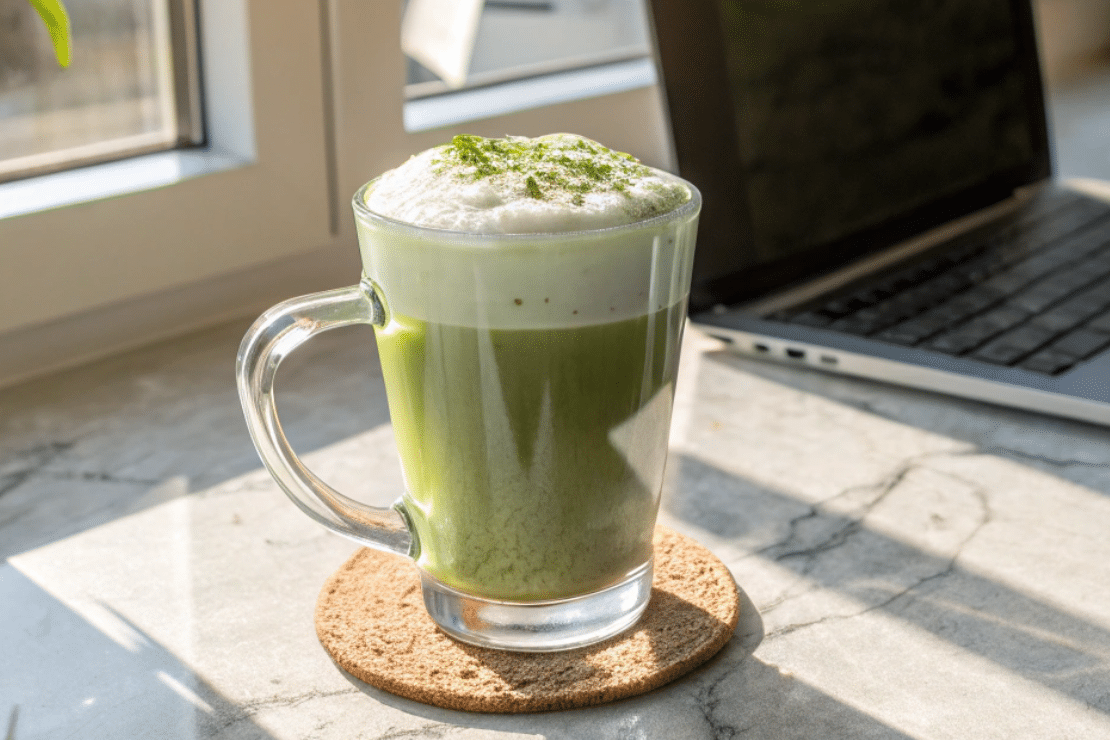Matcha latte tea has quickly become one of the most talked-about drinks in cafes, kitchens, and wellness spaces and honestly, I get why. Hi, I’m Siraj, and if you’re anything like me, you believe that food should tell a story and spark joy. My journey with food didn’t start with chef whites or a fancy kitchen; it started with curiosity. I grew up around the sizzling sounds of kefta, the vibrant smell of spices like ras el hanout, and the magic my mother could whip up with just a few ingredients.
That’s what LayRecipes is all about: creating dishes that bring comfort and connection. And matcha latte tea fits right into that mission it’s comforting, flavorful, and surprisingly simple once you get the hang of it.
In this article, we’ll break down what makes matcha lattes so special. From their health benefits and ingredients to how they differ from straight-up matcha, I’ve got everything you need to sip with confidence. We’ll also go over the best milk options, how to make it at home, and whether it can actually help with belly fat (spoiler: it’s not magic, but it’s promising). So, let’s stir up something amazing together.
Looking for inspiration? Try this simple guide to matcha green tea powder drinks to get a head start on flavor combos!
Table of Contents
What Is Matcha Latte Tea?
What exactly is matcha?
Matcha is a fine powder made from specially grown and processed green tea leaves. Unlike regular green tea, which you steep and discard, matcha lets you drink the whole leaf in powdered form. That means more nutrients, more flavor, and more kick. It’s traditionally used in Japanese tea ceremonies, but it’s gone global for a good reason it’s smooth, earthy, and packed with health perks.
How is matcha different from regular green tea?
Green tea is steeped. Matcha is consumed. That simple difference makes a big impact. While steeped tea gives you water infused with some of the leaf’s compounds, matcha delivers the entire leaf fiber, antioxidants, and all. Plus, matcha has more caffeine and a richer, more intense flavor. It’s the espresso of the tea world.
| Green Tea | Matcha Tea |
|---|---|
| Steeped | Whisked (powder form) |
| Lower caffeine | Higher caffeine |
| Mild flavor | Rich, umami taste |
| Less antioxidants | More antioxidants |
What goes into a matcha latte?
A matcha latte tea is basically matcha + milk (or plant milk) + a sweetener if you like. It combines the vibrant green of matcha with the creaminess of milk, creating a smooth, energizing drink that works hot or cold. Some folks add vanilla or cinnamon, but the core trio is always: matcha powder, milk, and hot water.
Check out this pink salt trick recipe for another simple and natural wellness addition to your day.
The Health Benefits of Matcha Latte Tea
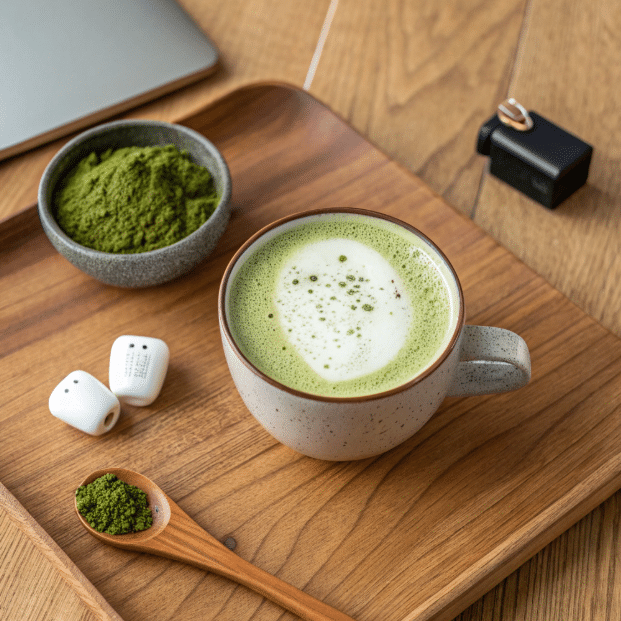
Is matcha tea latte good for you?
In short yes, matcha latte tea is good for you, especially when made right. Matcha is rich in antioxidants like EGCG (epigallocatechin gallate), which helps reduce inflammation, support cell repair, and fight oxidative stress. When combined with milk whether dairy or plant-based you get a dose of protein and creaminess that makes the drink both satisfying and nourishing.
But like anything, it’s all about balance. Matcha lattes made with too much sugar or artificial flavors lose a lot of their health appeal. Keep it simple, and you’ve got a cup full of benefits.
Don’t miss our Brazilian Mounjaro recipe that’s trending for weight-conscious eaters!
Antioxidants and catechins in matcha
Matcha is a powerhouse of catechins, especially EGCG, which is known for its ability to:
- Support immune function
- Help fight free radicals
- Reduce the risk of chronic conditions
Here’s how matcha stacks up compared to other superfoods:
| Superfood | Antioxidant Value (ORAC) |
|---|---|
| Matcha (2g) | ~1,400 units |
| Spinach (1 cup) | ~1,260 units |
| Blueberries (1/2 cup) | ~4,669 units |
While blueberries top the chart, matcha delivers these benefits in a concentrated, drinkable form that’s easy to enjoy daily.
Benefits for heart health and metabolism
Studies suggest that matcha may support heart health by helping regulate blood pressure and lowering LDL cholesterol levels. It’s also been linked to better metabolic function, thanks to its natural caffeine and L-theanine combination. This dynamic duo helps provide a calm, alert energy without the jitters you get from coffee.
Here’s what a daily cup of matcha latte may offer:
- Improved focus and alertness
- Better fat oxidation during workouts
- Support for blood sugar stability
Learn more about Brazilian Mounjaro for another metabolism-boosting recipe idea.
Print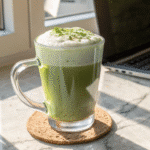
Easy Matcha Latte Tea
- Total Time: 5 minutes
- Yield: 1 serving
- Diet: Vegan
Description
Simple, creamy, and rich in antioxidants, this matcha latte tea is easy to make at home. Enjoy it hot or iced with just matcha, milk, and a hint of sweetness.
Ingredients
1 tsp matcha powder
2 oz hot water
6 oz milk (dairy or plant-based)
1 tsp honey (optional)
Instructions
1. Sift matcha powder into a bowl.
2. Add hot water (not boiling) and whisk until frothy.
3. Heat milk and pour into matcha mixture.
4. Sweeten to taste, stir, and enjoy.
Notes
For best results, use high-quality culinary or ceremonial-grade matcha from Japan.
If you’re new to matcha, start with ½ teaspoon and adjust as you get used to the flavor.
Oat milk froths beautifully and adds a creamy texture great for iced or hot versions.
Avoid boiling water it can make the matcha bitter. Aim for 170–175°F.
Want a sweeter latte? Try honey, date syrup, or maple syrup instead of flavored syrups.
- Prep Time: 5 minutes
- Category: Drinks
- Method: Whisking
- Cuisine: American
Nutrition
- Serving Size: 1 cup
- Calories: 90
- Sugar: 5g
- Sodium: 65mg
- Fat: 3g
- Saturated Fat: 0.5g
- Unsaturated Fat: 2.5g
- Carbohydrates: 12g
- Fiber: 2g
- Protein: 2g
Matcha vs. Matcha Latte – Know the Difference
What’s the difference between matcha and matcha lattes?
At first glance, matcha and matcha latte tea might seem like the same thing, but there’s a big difference in how they’re made and how they taste. Pure matcha is just finely ground green tea leaves whisked with water. It’s bold, earthy, and not sweet at all.
On the other hand, a matcha latte tea blends matcha powder with milk dairy or plant-based and often includes a natural sweetener like honey or maple syrup. The result? A creamier, milder drink that’s perfect for those new to matcha.
If matcha is the espresso of the tea world, matcha latte tea is the smooth cappuccino. It offers all the flavor of matcha with a cozy twist.
Which is healthier: straight matcha or matcha latte tea?
This depends on what you’re aiming for. A plain cup of matcha tea gives you the full benefits of antioxidants and caffeine without any extras. But when you make a matcha latte tea, you’re adding ingredients that can change its nutritional profile.
| Drink Type | Pros | Cons |
|---|---|---|
| Matcha Tea | Pure, low-cal, high EGCG | Strong taste, less creamy |
| Matcha Latte Tea | Creamy, beginner-friendly | Extra calories if sweetened |
That said, you can totally make your matcha latte tea healthy by using unsweetened almond or oat milk and skipping refined sugar.
How milk and sweeteners change the nutrition
When it comes to matcha latte tea, the extras you add make a big difference. Whole milk and sugary syrups can turn a health drink into a sugar bomb. But you don’t have to go that route.
Here are simple swaps to keep your matcha latte tea clean and nutritious:
- Use plant-based milks like oat or almond (unsweetened)
- Add raw honey or date syrup instead of flavored syrups
- Stick to one serving (1 tsp) of matcha powder per cup
Looking for inspiration? Try this pink salt trick recipe for weight loss to complement your healthy tea habits.
Does Matcha Latte Tea Help With Weight Loss?
Does matcha tea burn belly fat?
Many folks are sipping on matcha latte tea hoping it’ll melt away stubborn belly fat and while that’s a bit of a stretch, there is truth to the hype. Matcha contains EGCG, a powerful antioxidant that’s been linked to better fat metabolism and increased fat oxidation, especially when combined with physical activity.
But let’s be real: matcha latte tea isn’t a magic drink. It won’t make you drop pounds overnight. What it can do is support your efforts especially if you’re active, eating balanced meals, and staying hydrated.
Studies have shown that green tea extracts and matcha can enhance fat burning during exercise. So drinking a matcha latte tea before a workout might give your metabolism a little extra push.
Learn more about Brazilian Mounjaro if you’re exploring other ways to support a healthy routine.
Matcha’s impact on metabolism
Matcha has a unique combo of caffeine and L-theanine, which helps give you sustained energy without the crash. That means it’s great before a walk, a workout, or even a productive work session. The moderate caffeine in matcha latte tea may increase your resting metabolic rate slightly, helping your body burn more calories throughout the day.
Here’s what a cup of matcha (or your favorite matcha latte tea) might do for your metabolism:
- Boost fat oxidation (especially during cardio)
- Increase energy for movement
- Reduce appetite in some people
Of course, these effects vary. If you pair your matcha latte tea with sugary syrups or full-fat milk, you’ll cancel out those benefits fast. That’s why it’s key to keep your latte clean and simple.
Discover great ideas like the pink salt recipe that pairs well with fat-burning routines.
Realistic expectations vs. myths
Let’s bust a few myths. No, drinking matcha latte tea alone won’t shrink your waist. No drink can replace movement, good sleep, and real food. But if you’re looking for a natural way to support your weight goals, matcha is a solid ally.
Just remember these tips:
- Skip the sugar
- Stick to 1–2 cups daily
- Combine it with activity
- Focus on balance, not quick fixes
How to Make the Perfect Matcha Latte Tea at Home
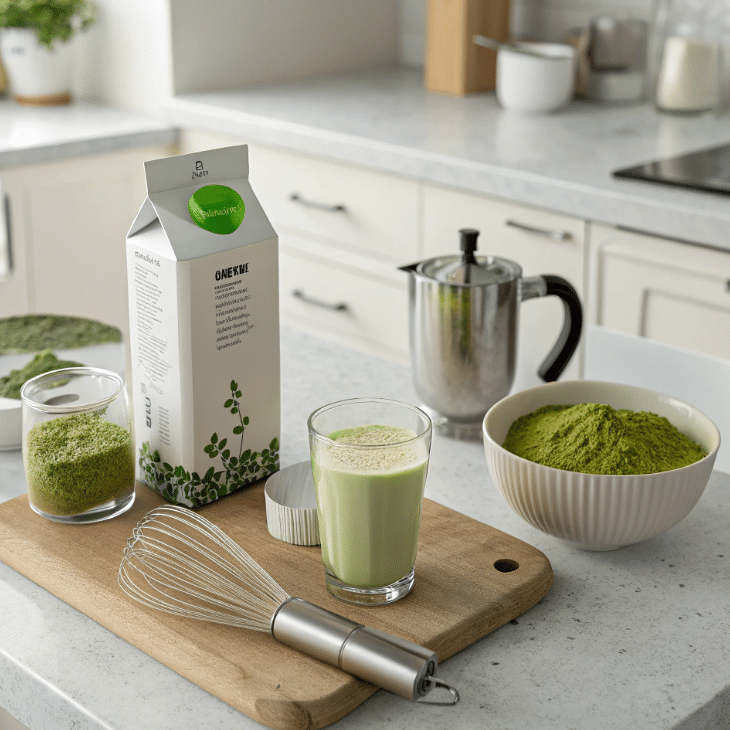
Tools and ingredients you need
Making matcha latte tea at home isn’t complicated especially when you’ve got the right tools. Here’s what you’ll want on hand:
Essential Tools:
- A bamboo whisk (chasen) or milk frother
- A small bowl or mug (preferably wide)
- A fine mesh sifter to remove clumps
- A kettle for hot (but not boiling) water
Simple Ingredient List:
- 1 tsp matcha powder (ceremonial or latte grade)
- 2 oz hot water (around 175°F / 80°C)
- 6 oz of milk (dairy, oat, almond, soy all work)
- Natural sweetener (optional): honey, date syrup, or maple
Don’t miss our pink salt trick recipe for another easy wellness boost you can prep with just a few ingredients.
Step-by-step guide: Traditional vs. modern method
Traditional Method:
- Sift the matcha into your bowl. This prevents clumps.
- Add the hot water (not boiling too hot ruins the taste).
- Whisk in an “M” or zig-zag motion until frothy.
- Warm your milk separately, then pour it into the bowl.
- Sweeten to taste if you like.
Modern Blender or Frother Method:
- Add matcha powder, water, milk, and sweetener to a blender.
- Blend for 20–30 seconds until creamy and smooth.
- Pour into your favorite mug and enjoy!
This method is faster and great for beginners.
Common mistakes to avoid
Even a small tweak can make or break your matcha latte tea experience. Here are a few common mistakes people make:
- Using boiling water: This makes matcha bitter. Keep it under 180°F.
- Skipping the sifting step: Clumps ruin the texture.
- Not whisking properly: A spoon won’t cut it use a proper whisk or frother.
- Over-sweetening: You want to taste the matcha, not just sugar.
| Mistake | Fix |
|---|---|
| Boiling water | Heat water to 175°F |
| Lumpy texture | Sift the powder first |
| Flat taste | Use fresh, high-quality matcha |
| Too sweet | Use a light hand with syrup |
Once you’ve got this process down, you’ll never want to hit the coffee shop for matcha latte tea again.
Best Types of Milk for Matcha Lattes (Dairy & Plant-Based)
Dairy vs. plant-based options: pros and cons
When it comes to crafting a creamy and delicious matcha latte tea, your choice of milk makes a big difference. The good news? There’s no one-size-fits-all answer just what works best for you.
Here’s a quick comparison:
| Milk Type | Texture | Flavor Profile | Best For |
|---|---|---|---|
| Whole milk | Creamy | Rich & slightly sweet | Traditional matcha lattes |
| Skim milk | Light | Neutral | Low-calorie version |
| Almond milk | Thin | Nutty | Light and low-cal |
| Oat milk | Creamy | Slightly sweet | Café-style lattes |
| Soy milk | Medium-thick | Mild & smooth | High-protein option |
| Coconut milk | Creamy | Strong coconut note | Tropical-style twist |
Each milk brings something different to the cup. Want café-style creaminess? Go for oat milk. Prefer something nutty and light? Almond might be your best friend.
Learn more about creating balanced drinks with our pink salt recipe that works well with your matcha habit.
Best non-dairy milk for a creamy texture
If you’re skipping dairy but still want that latte-like smoothness, oat milk is hands down the winner. It froths beautifully, has a mild sweetness, and complements the earthy notes of matcha latte tea.
Runner-up options:
- Soy milk: Good froth and protein boost
- Coconut milk: Great texture but can overpower the matcha flavor
- Almond milk: Refreshing but doesn’t froth as much
Pro Tip: Go for barista versions of plant milks they’re made to foam well and blend smoothly with matcha.
Flavor pairing tips
Here’s where it gets fun. Matcha latte tea can be elevated with just a hint of flavor from your milk choice. Some combinations work better than others:
- Oat milk + vanilla = café-style sweetness
- Almond milk + cinnamon = warm, comforting blend
- Soy milk + honey = smooth and slightly sweet
Avoid overly flavored or heavily sweetened milks they can overpower the matcha and throw off the balance.
Choosing the Right Matcha Powder for Lattes
Ceremonial vs. culinary grade: which is better?
When shopping for matcha, you’ll likely see two main types: ceremonial grade and culinary grade. So which one works best for matcha latte tea?
Here’s a quick breakdown:
| Matcha Grade | Best Use | Taste | Price |
|---|---|---|---|
| Ceremonial Grade | Drinking (no milk) | Smooth, mellow, vibrant | $$$ |
| Culinary Grade | Lattes, smoothies, baking | Slightly bitter, earthy | $$ |
While ceremonial grade is top-shelf quality bright green and delicate in flavor it’s not always necessary for a latte, since milk and sweeteners will mute its subtleties. Culinary grade matcha is more budget-friendly and bold, making it the better pick for most home latte lovers.
How to read matcha labels
If you’re staring at the back of a matcha pouch wondering what the info means, here’s what to look for:
- Origin: Look for matcha from Japan, especially regions like Uji or Nishio. These are known for high-quality green tea.
- Color: A vibrant green color means freshness and quality. If it’s dull or yellowish? Skip it.
- Ingredients: Only one should be listed: 100% matcha green tea powder.
- Packaging: Choose matcha in airtight, UV-protected tins or resealable bags to preserve freshness.
Trusted brands and what to avoid
It’s tempting to grab the cheapest option, but when it comes to matcha latte tea, quality matters. A low-grade matcha will taste bitter, dusty, and won’t blend well.
Look for brands that:
- Source directly from Japan
- Offer transparency about harvesting and processing
- Have fine, clump-free powder
Avoid matcha that:
- Has added sugar or fillers
- Comes in bulk without airtight packaging
- Smells like hay instead of fresh green tea
Don’t miss our guide on Brazilian Mounjaro recipes if you’re experimenting with wellness ingredients in your routine.
Fun Variations of Matcha Latte Tea
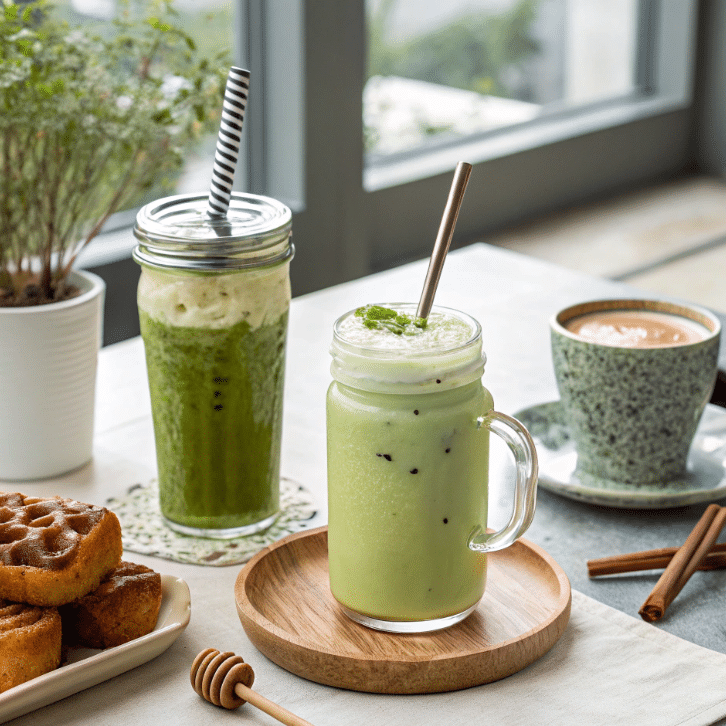
Iced matcha latte vs. hot matcha latte
Whether it’s sunny or snowy outside, matcha latte tea has you covered. The hot version is classic creamy, cozy, and great for slow mornings. But iced matcha? That’s the ultimate refreshment.
Here’s a quick comparison:
| Version | Best Time to Enjoy | Flavor Vibes | Pro Tips |
|---|---|---|---|
| Hot Matcha Latte | Cold mornings | Comforting, earthy | Use warm milk, not boiling |
| Iced Matcha Latte | Warm afternoons | Cool, crisp, slightly sweet | Use ice + cold-frothed milk |
Making it iced is simple: just whisk the matcha with a bit of warm water, pour over ice, and top with cold milk. That’s it!
Looking for something new? Try our pink salt recipe for weight loss alongside your iced latte for a power duo.
Adding vanilla, honey, cinnamon, or mint
One of the best things about matcha latte tea is how customizable it is. You can keep it minimal or jazz it up with natural flavors that complement matcha’s earthy tone.
Here are some tried-and-true combos:
- Vanilla Matcha Latte: Add a drop of vanilla extract or vanilla oat milk.
- Honey Cinnamon Matcha: Whisk in raw honey and a dash of cinnamon comfort in a cup.
- Mint Matcha Latte: Muddle a few mint leaves for a bright, cooling twist.
All these variations still deliver the benefits of matcha while keeping things exciting. No artificial flavors needed just a few pantry staples.
Matcha blends: turmeric, ginger, coconut
If you’re feeling adventurous, mix your matcha latte tea with other superfoods. These combos not only taste amazing but can offer added wellness perks:
- Matcha + Turmeric: Anti-inflammatory and beautifully golden-green.
- Matcha + Ginger: Zesty and soothing on the stomach.
- Matcha + Coconut Milk: Rich and tropical, perfect for iced versions.
Be sure to start small ¼ tsp of add-ins is usually enough to avoid overpowering the matcha flavor.
Side Effects and Precautions
How much matcha is too much?
While matcha latte tea offers plenty of benefits, moderation is key. Because matcha is made from whole green tea leaves, it contains a concentrated dose of caffeine and other compounds. Most health experts recommend no more than 2–3 cups per day, depending on your sensitivity.
Each teaspoon of matcha (roughly one latte) contains about 70mg of caffeine. That’s less than a coffee but still enough to affect energy levels, sleep, or digestion if you overdo it.
Too much matcha can cause:
- Upset stomach
- Headaches
- Insomnia
- Irritability (from excess caffeine)
If you’re new to matcha latte tea, start with half a teaspoon and gradually work your way up.
Check out our pink salt trick recipe to balance out your morning routine without relying on caffeine.
Who should limit matcha intake?
While matcha is generally safe, some people should keep their intake lower or avoid it altogether. That includes:
- Pregnant or breastfeeding women (due to caffeine)
- People with sensitive stomachs (matcha is slightly acidic)
- Those taking blood pressure or heart medications
- Anyone with iron deficiency, since green tea can block iron absorption if taken with meals
Tip: If you’re on medication or managing health conditions, talk to your doctor before making matcha latte tea a daily habit.
Signs of overconsumption
If your body isn’t vibing with your matcha habit, it’ll let you know. Look out for:
- Nervous energy or shakiness
- Trouble falling asleep
- Digestive upset
- Faster heart rate
If you notice any of these, scale back to 1 cup a day or swap in a decaf herbal option now and then.
That said, for most healthy adults, a cup or two of matcha latte tea daily is not just safe it’s a tasty wellness win.
FAQ About Matcha Latte Tea
Is matcha tea latte good for you?
Yes, matcha latte tea is good for you when prepared the right way. It’s packed with antioxidants, particularly EGCG, which supports heart health and metabolism. When you use quality matcha and skip excess sugar, it becomes a nourishing, energizing drink that’s also soothing and satisfying. Just don’t overdo the caffeine!
What is in a matcha tea latte?
A basic matcha latte tea contains just three ingredients: matcha powder, milk (dairy or plant-based), and hot water. Some people add a natural sweetener like honey or date syrup for extra flavor. You can also include vanilla, cinnamon, or mint for fun variations.
What’s the difference between matcha and matcha lattes?
Matcha is pure green tea powder mixed with hot water no extras. Matcha latte tea, on the other hand, adds milk and often a sweetener, making it creamier and more beginner-friendly. Matcha is strong and earthy; the latte version is smoother and often a little sweet.
Does matcha tea burn belly fat?
Matcha has been linked to improved fat metabolism and may help increase fat burning during exercise. While matcha latte tea isn’t a miracle fat-burning drink, it can support weight loss goals when combined with healthy eating and movement. Just keep it low-sugar and don’t rely on it alone.
Conclusion: Sip Smarter with Matcha Latte Tea
Matcha latte tea isn’t just a trendy green drink it’s a wellness-forward ritual that combines taste, comfort, and health in one cozy cup. Whether you prefer it hot or iced, simple or flavored, dairy-based or plant-powered, there’s a version out there that fits perfectly into your day.
From metabolism support to antioxidants, from choosing the right milk to picking the best powder, we’ve covered everything you need to create your ideal latte experience at home. Just remember: quality matcha, smart ingredients, and moderation go a long way.
Don’t miss our matcha green tea powder drink guide for more green tea goodness that’ll help you mix things up even more.
Thanks for reading, and happy sipping!
Siraj

